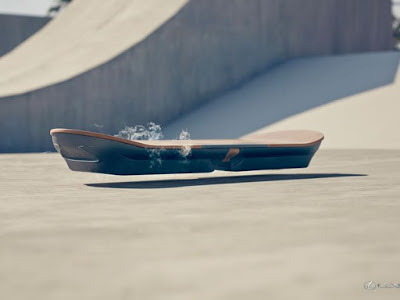Lexus announced Wednesday it has created a hoverboard.
“It works. It’s not a hoax,” says spokesman Moe Durand.
Lexus says it won’t be sold. It’s for demonstration purposes. It operates using magnetic levitation, with liquid nitrogen-cooled superconductors and permanent magnets that “combine to allow Lexus to create the impossible.” It says it is working with the world’s leading experts in super-conductive technology.
As cool as that sounds, there are some major limitations. Since it operates magnetically, it only can hover over a steel surface. And it also only works as long as the liquid nitrogen holds out.
The auto brand released pictures of the hoverboard floating above the ground, but no pictures of it in motion or with anyone standing on it. Durand says, however, it can support weight. Limitations aside, the hoverboard is sure to win fans — maybe even sell a few cars.
There is propeller hoverboard that can fly over 2 full sized football pitches and has no limitation of flying over metal
In the incredible footage below Catalin reaches a height of 5 meters on his prototype hoverboard covering a distance of over twice that of two full sized football pitches before gently landing in the exquisite waters of Lake Ouareau in Quebec, Canada.
He claims that the machine, which he built and designed over the course of 12 months, can be used anywhere and can reach ‘scary heights’ which he would like to potentially explore in the near future.
Several others working on magnetic hoverboards
Arx Pax’s system is potentially much less expensive than existing maglev systems, which rely on complex electromagnetic systems in both vehicle and tracks and can cost tens of millions of dollars per mile.
Arx Pax’s magnetic engine is entirely contained within the object being levitated, and the only required infrastructure is a conductive surface, such as the copper-lined halfpipe used to demo the hoverboard. This means systems of any scale could be laid quickly and cheaply. Even more impressive, the surface can be multi-use—for instance, a roadway consisting of a layer of asphalt over copper could accommodate both maglev and conventional vehicles.
The Arx Pax engine can also generate thrust and directional control magnetically, so it doesn’t need a track for guidance. One of Arx Pax’s prototypes is a scaled-down hover vehicle called the Manta Ray, which zigs and zags as neatly as a remote control car. According to Henderson, this points towards “a new type of vehicle, a hybrid vehicle that can drive conventionally, or can hover . . . [with] all the freedom of a car and all the efficiency of a train.”
But this futuristic dream of roads full of flying cars faces some obstacles. Arx Pax’s hover engine is power-hungry, needing 40 watts of energy to levitate one kilogram. In October, he says a new version will debut that’s smaller, lighter, and more powerful.
The M3 maglev system that Magnemotion piloted was able to levitate over 10,000 pounds with a hundred watts.
Hendo had a kickstarter in 2014
While their hoverboard is primarily intended to be self-propelled, the actions which stabilize it can also be used to drive it forward by altering the projected force on the surface below.
Currently, this surface needs to be a non-ferromagnetic conductor. Right now they use commonly available metals in a simple sheets, but they are working on new compounds and new configurations to maximize our technology and minimize costs.
Want to develop Hoverparks
While one day we expect to have hoverboards that can effortlessly float over any medium (even water!), our current technology requires special types of surfaces.
Therefore, we need a hoverpark to go with our boards, and we have been busy designing a park befitting the awesomeness of our technology.
SOURCES – Youtube, Fortune, Guiness Book of World Records, National Geographic, USA Today

Brian Wang is a Futurist Thought Leader and a popular Science blogger with 1 million readers per month. His blog Nextbigfuture.com is ranked #1 Science News Blog. It covers many disruptive technology and trends including Space, Robotics, Artificial Intelligence, Medicine, Anti-aging Biotechnology, and Nanotechnology.
Known for identifying cutting edge technologies, he is currently a Co-Founder of a startup and fundraiser for high potential early-stage companies. He is the Head of Research for Allocations for deep technology investments and an Angel Investor at Space Angels.
A frequent speaker at corporations, he has been a TEDx speaker, a Singularity University speaker and guest at numerous interviews for radio and podcasts. He is open to public speaking and advising engagements.







